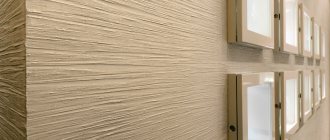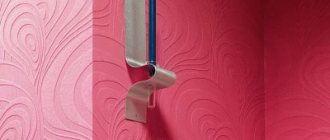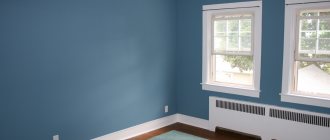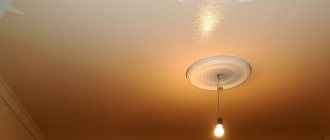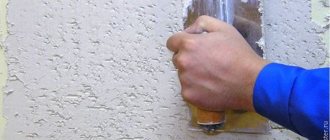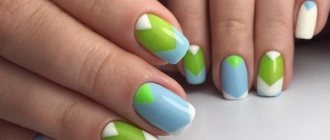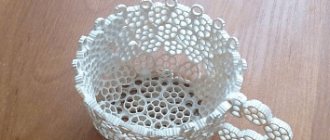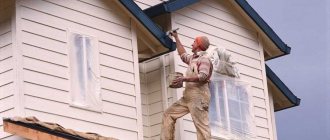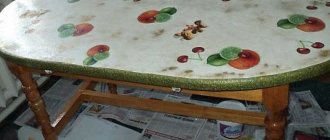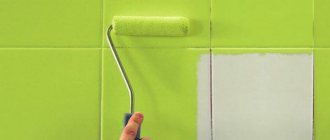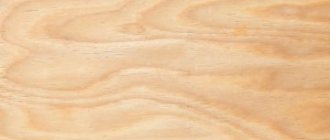The trends in modern construction are such that many residents, having received a warrant for their own apartment, immediately begin renovation work: building partitions, laying floors, installing interior doors and doing finishing work on ceilings and walls. Sales analysis shows that the share of water-dispersion paints reaches up to 25...30% of total sales of consumable building materials. They are technologically advanced enough for residents to do the painting work on their own. The price range is quite attractive. I like the relatively low consumption - from 200 to 300 ml per square meter of the surface to be painted.
Water-based and water-dispersed paints
The differences between water-based and water-based paints are as follows:
- for water-based paints, all components are in the form of a chemical solution without suspended particles;
- Water-dispersed paints contain suspended particles. This is a colloidal solution of coloring pigments in a solvent.
Even when selling online, sellers sometimes cannot tell the difference between these consumables. The main difference is that water-dispersed coatings are thicker and more durable, the consumption of dyes is at least 330 ml per sq.m.
Main types of water-dispersed paints based on bases and their characteristics
Developers annually offer dispersions with new inclusions and binding components. Relatively new proposals include some decorative emulsion and water-dispersion paints that form an unusual texture, for example, imitating stone. They are applied to any primed substrate, including wood and metal.
Modern water-based enamels are classified by type of application:
- Facade;
- Interior.
They contain common components, for example, to protect against mold and mildew, but they all differ in composition and characteristic properties. There are also latex and hammer compounds with special effects.
Developers annually offer dispersions with new inclusions and binding components.
Polyvinyl acetate
PVA-based paints are characterized by low hydrophobicity, so they should not be used in damp rooms. They are suitable for painting plastered ceilings in an apartment with a stable temperature regime. This is a budget option for cosmetic repairs.
They are suitable for painting plastered ceilings in an apartment with a stable temperature regime.
Acrylate
Dispersion paint with the addition of acrylates remains the most popular due to its optimal price-quality ratio. It is resistant to UV rays, so it is recommended for interior use even on the south side. A vapor-permeable elastic coating is also guaranteed.
The waterproof composition is easy to use, the layer does not crack even with a noticeable temperature difference. But this does not mean that you can experiment as facade coatings if the packaging says “for interior use.” The advantage is a perfectly flat surface after painting, regardless of the base material.
The waterproof composition is easy to use, the layer does not crack even with a noticeable temperature difference.
Latex or styrene butadiene
Styrene-butadiene dispersed compositions are moisture resistant, but their pigment quickly fades when exposed to sunlight. The interior is the place to be. These are latex compounds based on synthetic and organic rubber-type resins that look great after drying.
Application - bathrooms, bathtubs and showers, as they perfectly resist dampness and are easy to clean. You can paint insulated attics, basements and wine cellars. The walls of glazed loggias and balconies are quite acceptable, provided that a dim shade is used (the polymer quickly fades in the sun).
Application - bathrooms, bathtubs and showers, as they perfectly resist dampness and are easy to clean.
Silicone
If we talk about what silicone water-dispersion paint means, then it is worth focusing on its specialization. Known to specialists as a façade dye of excellent quality. These mixtures are distinguished by their ability to repel dirt and water, cleaning the wall during rains. Therefore, the building near the road will remain clean even in bad weather.
The coating will protect the walls from any influences, while maintaining high aesthetics and uniform processing. With this composition, specialists work on basement and facade surfaces - brick, concrete and plaster. It is noteworthy that matte and glossy variations are offered for facade work.
The coating will protect the walls from any influences, while maintaining high aesthetics and uniform processing.
Dispersive silicate
Silicate dyes are also water-based. Liquid glass and sodium ethyl silicate in its composition explain their name and classification - mineral paints. Main varieties:
- Dispersed silicate (acrylic added);
- Silicate-silicone.
The basic requirements for compositions and their properties are regulated by GOST.
Silicate dyes are also water-based.
Features of water-based paint: pros and cons of use
Users note various advantages of water-based paints over other paints and varnishes:
- the high drying speed is liked by craftsmen and amateurs who carry out repairs using these coloring compounds;
- the absence of pungent odors during work, as well as after drying, attracts everyone; gases harmful to health are not formed; during work, there is no need to use complex eye and respiratory protection devices;
- By adding the desired color to a can of white paint, you can achieve any shade. Here the user's imagination receives food for experimentation. Even the most fantastic colors can be achieved;
- It’s easy to wash off residues from your hands, face and clothes; water with the simplest detergents will remove traces of coloring components;
- The technology for applying paint to ceilings, walls and other surfaces is simple; after an hour of work, any amateur becomes a professional who can boast of the results of his work.
The disadvantages of water-based paint are:
- the need for storage at a positive temperature, it cannot be left on the balcony waiting for warming, the structure is destroyed when frozen and cannot be restored;
- Basically, water emulsions give a matte finish;
- The dyeing process must be carried out at temperatures above +5...+7 °C.
Types of emulsion paint
There are several types of water-based paint:
- polyvinyl acetate;
- acrylic;
- latex;
- silicate;
- silicone.
The technical characteristics of paints determine the scope of their application. But regardless of the type of water-based emulsion, it always consists of tiny polymer particles, but differs in viscosity, specific gravity, drying time, shelf life, and the presence of an antiseptic. Some properties of different paints are the same:
- they do not have a distinct odor;
- when drying, they do not emit toxic fumes;
- easy to apply to any surface, except those previously painted with enamels;
- When painting metal elements, they accelerate the process of corrosion.
Types of water-based paints
Depending on the type of binder used, it is customary to divide water-based paints into:
- acrylic, acrylic resins are used here, they determined the name. Most users prefer them. After drying, a durable film is formed that can be washed if necessary. Some cans indicate that the coating can withstand up to five thousand wet washes. As an additional option, crushed latex may be present; it significantly improves the properties of the paintwork, it is better resistant to atmospheric influences, and also becomes resistant to UV radiation;
- silicone ones contain high molecular weight silicone resins. They have high hiding power and can paint over surfaces with cracks, since the coating penetrates deeply into the walls. Usually silicone is present together with acrylic, which improves the structure of the painting composition. The high cost is compensated by special properties, which is why painters love this type of paint. The layer is vapor permeable, it is recommended even for damp rooms; fungus and mold do not form on painted walls;
- silicate are a solution of liquid glass in which colored pigments are present, silicate coating has a number of advantages: long service life (up to 20 years), weather-resistant, can be used for painting facades and fences, protects against fire;
- mineral ones use cement or lime as binders, the main area of application is painting brick and concrete walls. The main disadvantage is the limited service life;
- polyvinyl acetate contains finely ground pigments on a polyvinyl acetate base, forming a fairly durable coating that is resistant to moisture, fats or mineral oils. When exposed to sunlight, it does not decompose within 10...15 years.
Properties
Water-based paint is distinguished by a unique application technology. From the point of view of the person applying the paint, the painting process is the same, but at the molecular level there are major changes in composition. Before application, the paint is water with many additives mixed in it. These particles are not dissolved in water, but are simply mixed in it, and being in this state, they do not interact with each other.
When applied to the surface, a significant change in composition occurs:
- the water evaporates, activating the paint particles;
- the binding substances come closer together, turning into an even, homogeneous layer;
- Hardeners impart relative rigidity to the coating.
Considering that the solvent in these types of paints is water, no harmful or toxic substances are released during evaporation. The fire hazard of painting work is also minimized.
Another clear advantage is durability and the ability to apply a new coat directly over old paint. Before applying a new coat, there is no need to carry out special treatment or remove old paint (provided that the old coating was not oil-based).
A negative property of water-based paint is the corrosion effect when pure metal comes into contact with water. But a number of manufacturers, using modern additives, have launched paint production that minimizes such consequences.
Compound
The exact composition will vary depending on the paint manufacturer and its purpose, and is usually kept secret by the company. But, without going into the smallest details, it can be said that any water-based paint consists of the following components:
- 40-60% water and film former dissolved in it;
- 30-40% fillers and coloring pigments;
- 5-10% plasticizers;
- 5-10% other additives.
To create façade paints, antifreeze is always used to withstand negative temperatures, and acrylic resins to impart elasticity to the finished paint layer. Ultraviolet and infrared filters are also used to prevent damage caused by solar activity. Waterproof paint is obtained by adding synthetic rubber or its analogues to the composition.
Best before date
Shelf life directly depends on storage conditions. Manufacturers guarantee complete safety of the product for at least 6 months, the same period is fixed by the current GOST. The paint should be stored in sealed original packaging without exposing it to sunlight. The storage temperature is strictly positive, from +5 to +30°C. Transposition is allowed at negative temperatures, but not more than 1 month.
In fact, the paint can be stored at least twice as long, and some manufacturers still indicate a period of 12 months on the packaging. After this period, the paint will begin to lose its properties, but for local work, many people use 2-year-old remains of already open paint. It is better to comply with the temperature requirements, because a significant part of the paint is water, which can turn into ice.
Viscosity in DIN
According to the current GOST, the viscosity of water-based paints is at least 30din. The vast majority of manufacturers supply paint with a viscosity of 50-60 or more, for subsequent dilution with a solvent. Measurements must be carried out at paint and ambient temperatures within 18-22°C, otherwise the indicators will not be correct.
Depending on the method of applying paint, the optimal viscosity of the composition will change:
- 20-25 when using a spray gun;
- 30-40 for a roller
- 40-50 for a brush.
When diluting water-based paint with water, it is recommended to use only distilled water. Ordinary water from the tap or the nearest body of water is not suitable due to the various impurities it contains. When applying paint with such water to a surface, white marks and stains will remain after the water evaporates.
Manufacturers of water-based paints
On the Russian market, various manufacturers offer their products for painting walls and ceilings. The modern buyer has a choice.
Dulux (Great Britain) offers water-based emulsion for various purposes, the largest range of interior paints. A look at the composition shows that the main emphasis is on acrylic dyes.
Rice. 1 Facade paint for wooden fences produced by Dulux Products are offered with different properties depending on the strength of the film created, the emphasis is on narrow specialized use. Hence the rather high price range; a higher quality product is sold at a higher price.
Caparol (Germany) describes all the advantages of its product with German meticulousness. The quality of the paints is the highest. The price is high. Painted products do not need to be repainted for decades. You need to require a certificate of conformity, sometimes you can buy something else instead of German quality;
Rice. 2 Silicone based paint
Tikkurila (Finland) – Finnish paints have proven themselves well in the Russian market, craftsmen especially appreciate products for outdoor work, the price is somewhat lower than German ones, and the quality is often even higher;
Rice. 3 Latex paint from Tikkurila
Dufa (Germany) is another German representative; the products of this manufacturer are purchased by wholesalers for painting large objects. Sensitive discounts are noted here. Paints were in great demand during the construction and modernization of stadiums for the World Cup. Dufa was the main supplier;
Rice. 4 Latex paint for kitchens and sanitary units from Dufa
Sniezka (Poland) is a Polish manufacturer of paints; in a number of regions of the Russian Federation its products are presented in a wide range. The quality is not bad, in many respects it corresponds to domestic products.
Rice. 5 Paint for walls and ceilings from Sniezka What makes Sniezka products attractive is that they offer paint in containers from 400 ml to 70 liters. The buyer can always choose the right quantity so as not to spend money on unnecessary volumes;
Admiral (Russia) is a domestic manufacturer that produces good quality paints. Claims sometimes arise against a retail chain that does not organize proper storage. Water-based paints are resistant to freezing;
Rice. 5
Eurolux (Russia) - this manufacturer produces paints of excellent quality. They can compete with English, Finnish and German ones. The main advantage is that with excellent performance, the price of Eurolux is one and a half to two times lower.
Rice. 7 Acrylic-based paint about Eurolux
Which water-based paint should a home craftsman choose? When choosing a dye for repair work, you should know exactly for what conditions the material is being purchased. If you need to paint the ceiling, you should not buy a more expensive product. The coating on the ceiling does not experience mechanical stress, so it needs to be purchased purposefully. The price varies quite widely.
If you use ceiling paint for walls, then you can expect the phenomenon of delamination of the paint coating. You will have to make claims to yourself. A stingy person will definitely pay twice. This principle is clearly visible when purchasing and using water-based paints.
Preparing the Paint
Dilution of paint
The paint in the can has a thick consistency. The undiluted composition is excellent for creating relief compositions, but it is too thick for regular painting. In this regard, the emulsion is first thoroughly stirred, and then water is added to it. The quantity is determined based on the recommendations of the manufacturer or empirically. Water is added until the paintwork reaches the desired consistency. Properly diluted paint resembles the density of full-fat milk.
If you plan to use a spray gun, tap water will not work, since after the coating dries, a whitish coating will form on it. In this regard, distilled water or alcohol is used for dilution.
The paint must be diluted immediately before use. After 15-20 minutes the composition thickens. If this time is missed, the paint should be diluted again.
Tinting
The water-based composition is offered in white. If you want to give the paint a different color, add pigment to it. This can be done at home or directly in the store, if they have specialized equipment.
If you do the tinting yourself, it is recommended to purchase pigment with a reserve of 10-15%. This will allow you to recreate the composition to renew the coating without any problems in the future.
The color is added gradually, after which the solution is thoroughly mixed. If the intensity of the resulting shade is not satisfactory, then you need to add more pigmenting substance.
First, you should dilute a little tinted paint, which will allow you to see how it will look on the painted surface. Moreover, the shade of the dried coating differs from the color of the liquid coating. You also need to keep in mind that paint that has expired or has been stored incorrectly may have a significantly different color (compared to the original) and have poor adhesion to the surface. Poor quality paint forms a bubble coating or simply runs off the surface completely.
Paint consumption
The approximate consumption per m2 is indicated by the manufacturer on the can. Based on these data, it becomes possible to plan the consumption of paints and varnishes.
You can also calculate the amount of paint needed based on the General consumption standards for water-based paints and varnishes:
However, it should be remembered that consumption rates for 1 m2 of the same paint can vary greatly depending on additional factors. In particular, we are talking about the type of material being painted. A smooth surface absorbs 15-20% less paintwork compared to a rough surface.
Note! When calculating, the number of layers is taken into account. Most often, one layer is not enough to paint the surface - you will need at least 2-3 of them
The material consumption is also affected by the tool used. For example, using a spray gun allows you to reduce the consumption of paintwork materials, but only if painting is carried out in calm weather.
Consumption also depends on air temperature and humidity. In hot weather, the liquid quickly evaporates from the dye, and therefore the coating is formed unevenly and layers have to be reapplied. Additional losses of paintwork materials are a common occurrence when painting a ceiling, since the composition simply flows down.
Tools
To apply paint use brushes, rollers or sprayers. Brushes are the best option for finishing small surfaces with many corners and convex details. A spray bottle is a convenient tool, but not everyone has it, and buying it for one painting is not always advisable. Therefore, a roller is often the best method for painting a surface.
There are several types of rollers:
- Foam rubber. They are characterized by low cost. They absorb too much dye, causing bubbles and unevenness to form on the coating.
- Velor. They are more difficult to buy due to their lower prevalence. Velor rollers are characterized by low absorbency. This property has a positive effect on the quality of painting, but you will have to dip the roller very often.
- Fleecy. The best option for painting. There are rollers on sale with different lengths of pile (affects the thickness of the layer). The most expensive fleecy rollers are made from felt and fur. Polyamide fiber rollers are also a good choice.
Applying paint
The prepared paint and varnish material is poured into a painting tray. To make painting more convenient, reaching to the most remote areas, a long handle is attached to the roller. For this purpose, use a plastic tube or a light wooden holder.
Apply paint starting from the corner of the wall. Moreover, it is painted over with a brush. Then they dip the roller into the paint, press it onto the pallet and make movements downwards and then up. The thickness of the applied strip is equal to the width of the roller. Each subsequent strip is overlapped with the previous one. In this way, visible boundaries between the stripes are avoided. You need to paint quickly in order to have time to use up all the diluted paintwork.
Apply 2-3 layers of water-based composition to putty walls. Each time they wait until the coating dries, and only then begin to apply a new layer. On average, the break is 3-4 hours.
Note! When applying paint to wallpaper, one layer is enough
Features of the material
Before purchasing, you need to study some basic indicators of this composition:
- Viscosity is a characteristic of a substance, which is determined by the degree of concentration of water in the paint. The indicator is measured with a viscometer. To use a roller or brush, the viscosity should be 40–45 St. If the composition is applied using a spray gun, then no more than 25 Art.
- As for consumption, we can’t say for sure. The average is 180 ml per square meter. But this amount may vary depending on the characteristics of the surface being treated, the tools used and the quality of the paint. The specific gravity of the material is 1.4 kg/l.
- Drying time ranges from 2 hours to a day. This difference is explained by the fact that in damp rooms and without proper ventilation, water evaporates less intensely. The recommended operating temperature is 20 degrees Celsius and air humidity is 70%.
- The shelf life of water-based paints is limited to 24 months from the date of production. Once opened, the paint should be stored in a cool, dark place and should not be allowed to freeze.
